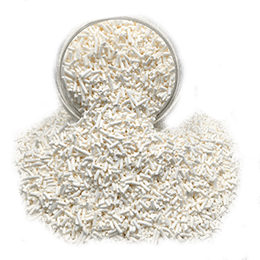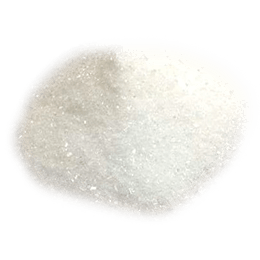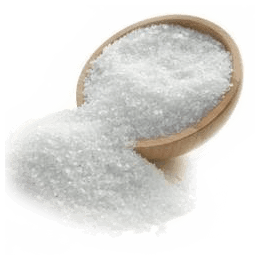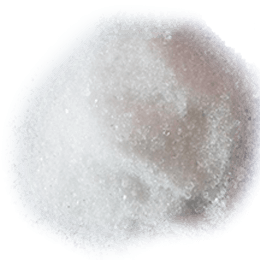Preservatives and Antimicrobials

1- Potassium Sorbate PRODUCT CODE: E-202
Explanation: Potassium Sorbate, found in the fruit of the plant called rowan tree, is an organic acid and dissolves in water or alcohol. Potassium Sorbate, a white-cream colored granule, is affected by light and air. Organic acids are generally not used in food products. Potassium Sorbate is the only organic acid that is allowed to be used in food. Due to some of its properties, it is less harmful than some preservatives in some places. In the late 1930s, it was proven that sorbic acid and its salts prevent the growth of microorganisms. Therefore, the use of Potassium Sorbate in the food industry has increased. It does not have a pronounced taste and odor. It is slightly soluble in alcohol but has a high solubility in water. It is used in most food products. It is effective against many bacteria such as mold yeast. It is used in food products by packing, sprinkling or spraying. It is used in many foods and beverages. Potassium Sorbate protective effect is 10 times higher than sodium benzoate. As it extends the storage life of the food, it helps to keep the taste of the food as on the first day and to protect the aroma that is unique to the food. And it also does not limit the growth of beneficial bacteria in food. It has a wide range of effectiveness in preventing molds, yeasts and most bacteria.
Usage areas: It is used in food products and food product packages. It is used in many areas such as tomato paste, bread, margarine, jam, fish, confectionery, mayonnaise, cheese, wine, yoghurt, fruit products and bakery products. Because it has a neutral flavor, it is used in fruit juices and wine to prevent secondary fermentation of increased sugar. It is used to correct shine in coating and as an intermediate in the production of plasticizers and lubricants. It is applied by pulverizing the outer surface after the sausage fillings. It is generally applied as a 15% solution in foods. Apart from food and beverage, it is used in cosmetics, medicine, tobacco and flavoring products. It is resistant to high temperature and therefore can be used easily in heat treated foods.
2- Sodium Benzoate PRODUCT CODE: E-211
Explanation: Sodium benzoate is one of the sodium salts of benzo acid and is a food additive chemical obtained by neutralization with sodium bicarbonate, sodium carbonate or sodium hydroxide. Sodium Benzoate is a white colored food additive chemical in physical form of granule or powder. Sodium Benzoate, which is solid at room temperature, is a flammable substance and dissolves well in water. When Sodium Benzoate is used in the food industry, it works against mold and yeast rather than bacteria by acting antagonist with potassium sorbate. Bacteria's sensitivity to Sodium Benzoate is very low. Sodium Benzoate is mostly used at a rate of 0.1% in our country, it is not allowed to use more than 0.1%.
Usage areas: Sodium Benzoate is used as a preservative against mold and yeast in food, medicine and cosmetics. It is mostly used in carbonated beverages and similar soft drinks, pickles, margarine production, canned food, sauces, ketchup and similar preparations, in foods such as marmalade jam, olive production, confectionery, jelly fruit salads and processed fish products. Apart from this, Sodium Benzoate is also used in the pharmaceutical industry, cosmetics industry, and toothpastes.


3- Sodium Metabisulfite Product Code : E-223
Explanation: Sodium Metabisulfite, also known as the disodium salt; It has functions such as a sterilizing agent, antioxidant and preservative. When mixed with water, it releases sulfur dioxide. This gas, which has a bad odor, causes allergic reactions in the body, especially skin irritation and asthma in some people. For these reasons, its use has decreased recently. Care must be taken when using it. Sodium metabisulphite; commercially available in technical, food and photographic types.
Usage areas: Sodium metabisulphite; It is used as an anti-browning agent, antioxidant, flour processing agent or preservative in food products. It is used in seafood as a preventive from darkening caused by pigments. It is used in the removal of excess chlorine, which is commonly used in water treatment, tanning, textile, food and beverage and pulp processing industries, and also photochemically. It is used as a reducing agent for purification and isolation of aldehydes and ketones in the chemical and pharmaceutical industry; It is used for cleaning and bleaching wool, jute and other vegetable fibers. Photographic type is used for acidification of film baths.
4- Tri Sodium Citrate PRODUCT CODE: E-331
Explanation:In citric acid monohydrate max. Unlike anhydrate, since it contains 8%, its application area is mostly liquid products. It has a white sand-like appearance. Citric Acid Monohydrate has good solubility in water. It is a stable chemical. Does not react with bases, strong oxidizing agents, reducing agents and metal nitrates. Citric Acid Monohydrate is completely biodegradable.
Usage areas:Citric Acid Monohydrate is used in baking powder in the production of bakery products and snack products produced in baby foods and baby products, bakeries and such places. The purpose of use of Citric Acid is to add acidity. It is used in confectionery to add acidity taste. So the citric acid Monohydrate used here is used to lower the pH. It is used to increase the durability of the gel in sugars that require preservative chemicals. It is used to provide clarity and acidity in wine production. It is used for cleaning in kitchens and bathrooms and as a citrus based acid, it is also used as a deodorizer due to its pleasant aroma. There is even a small amount of citric acid in shampoos, body washes, facial cleansers, hand soap, nail polish and different cosmetics.

